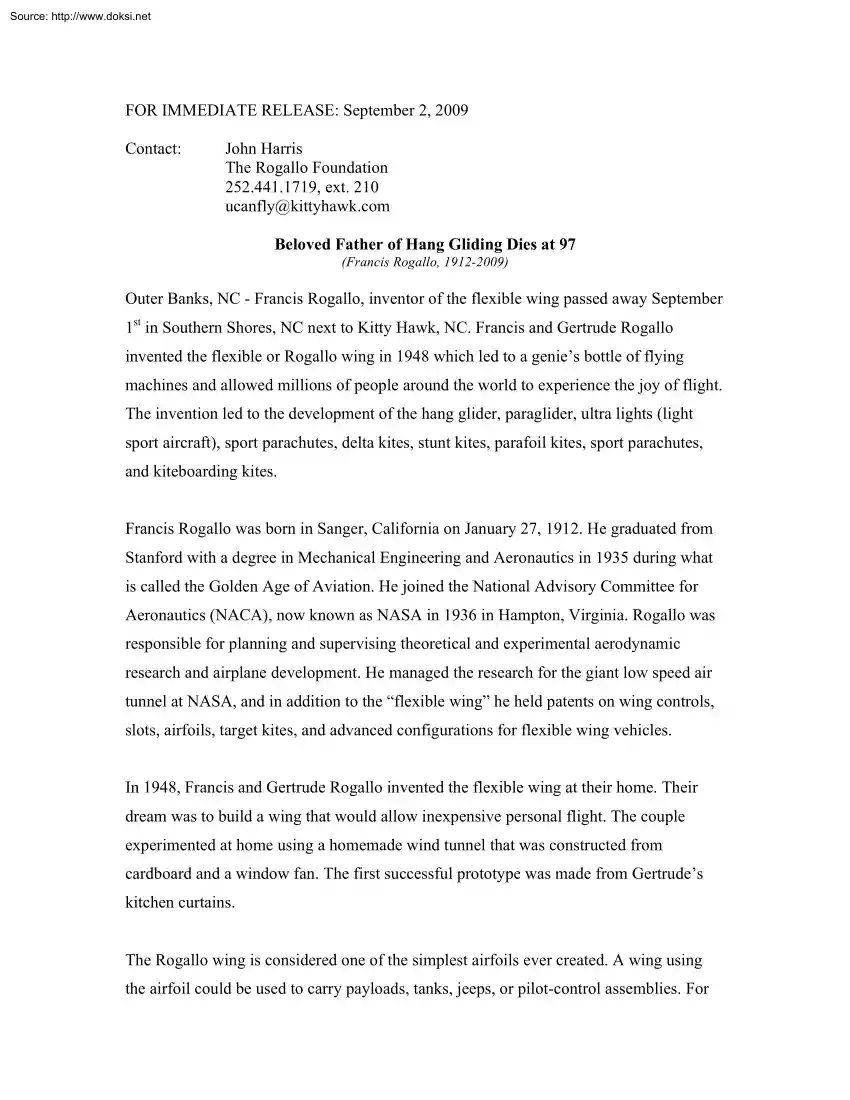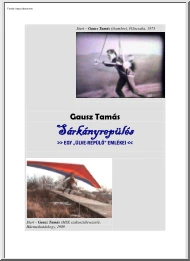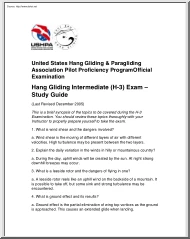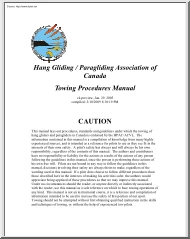Datasheet
Year, pagecount:2009, 4 page(s)
Language:English
Downloads:2
Uploaded:February 25, 2019
Size:517 KB
Institution:
-
Comments:
Attachment:-
Download in PDF:Please log in!
Comments
No comments yet. You can be the first!Content extract
Source: http://www.doksinet FOR IMMEDIATE RELEASE: September 2, 2009 Contact: John Harris The Rogallo Foundation 252.4411719, ext 210 ucanfly@kittyhawk.com Beloved Father of Hang Gliding Dies at 97 (Francis Rogallo, 1912-2009) Outer Banks, NC - Francis Rogallo, inventor of the flexible wing passed away September 1st in Southern Shores, NC next to Kitty Hawk, NC. Francis and Gertrude Rogallo invented the flexible or Rogallo wing in 1948 which led to a genie’s bottle of flying machines and allowed millions of people around the world to experience the joy of flight. The invention led to the development of the hang glider, paraglider, ultra lights (light sport aircraft), sport parachutes, delta kites, stunt kites, parafoil kites, sport parachutes, and kiteboarding kites. Francis Rogallo was born in Sanger, California on January 27, 1912. He graduated from Stanford with a degree in Mechanical Engineering and Aeronautics in 1935 during what is called the Golden Age of Aviation. He
joined the National Advisory Committee for Aeronautics (NACA), now known as NASA in 1936 in Hampton, Virginia. Rogallo was responsible for planning and supervising theoretical and experimental aerodynamic research and airplane development. He managed the research for the giant low speed air tunnel at NASA, and in addition to the “flexible wing” he held patents on wing controls, slots, airfoils, target kites, and advanced configurations for flexible wing vehicles. In 1948, Francis and Gertrude Rogallo invented the flexible wing at their home. Their dream was to build a wing that would allow inexpensive personal flight. The couple experimented at home using a homemade wind tunnel that was constructed from cardboard and a window fan. The first successful prototype was made from Gertrude’s kitchen curtains. The Rogallo wing is considered one of the simplest airfoils ever created. A wing using the airfoil could be used to carry payloads, tanks, jeeps, or pilot-control assemblies. For
Source: http://www.doksinet years the couple tried ceaselessly to attract both government and industry interest in their flexible wing, and they licensed a manufacturer in Connecticut to sell a kite based on it. When the DuPont Company announced the development of Mylar in 1952, Rogallo immediately saw how superior it would be for his kite, and the five-dollar toy “Flexikite” became one of the first products to use the plastic material. The Rogallos found themselves traveling to kiting events around the Northeast to fly and promote the toy. It was on October 4, 1957 when the Russian Sputnik began beeping its message from orbit that everything changed, and the space race caught the imagination of the newly formed NASA. The Rogallos gave their patent to the government so that it would be used for public good, and with Francis Rogallo’s help at the wind tunnels, NASA began a series of experiments testing the Parawing (NASA renamed the Rogallo wing the Parawing. Modern hang glider
pilots still refer to it as the Rogallo wing) The wing was tested at altitudes as high as 200,000 feet and as fast as Mach 3 in order to evaluate it as an alternative recovery system for the Gemini space capsules and spent rocket stages. By 1960 NASA had already made test flights of a framed Parawing powered aircraft called the “flying jeep” or Fleep and a weight shift Parawing glider called Paresev that was both manned and unmanned. In 1967 NASA stopped projects focused on the Parasev in favor of using round parachutes. NASA was not in the business of applying Rogallo’s family of airfoils to personal aircraft such as hang gliders and powered light aircraft, however the technology used in the Paresev series of aircraft provided all the fundamental mechanics that could be simplified to create a lighter personal aircraft. The task of modifying what the Paresev team had done with the Rogallo Wing was taken up by independent designers around the world: Barry Palmer in 1961, Richard
Miller, Thomas Purcell, and Australians John Dickenson, Bill Moyes and Bill Bennet were among the first to tap into the technology for manned personal-craft glider/kite use, also known as hang gliding. As people became aware of the concept, the development of a multifaceted line of flexible wings was developed including: the hang glider, ultralight aircraft, paragliders and sport parachutes, flexible wing kites or parafoils, delta kites, stunt kites, power kites, kiteboarding kites and Source: http://www.doksinet snow kites. Certainly new developments will continue as the original ideas are mixed with the imagination and dreams of future generations. Mr. Rogallo has been recognized worldwide for his contributions to sport aviation He has been honored in Japan, Australia, Switzerland, Germany and France for his contribution to personal flight and is considered the Father of hang gliding around the world. Millions of people around the world have enjoyed flight as a result of
Rogallo’s invention of the Flexible Wing. In 1963 NASA awarded Mr. Rogallo the highest cash award to date for his generosity of freely giving the government the use of his patents. He was inducted into the NC Sports Hall of Fame in 1987, and on May 11,1997, the NASA Langley Research Center recognized Mr. Rogallo “for (your) many contributions to flight” Rogallo has also been recognized by the National Air and Space Museum of the Smithsonian Institute “for outstanding achievement in aerospace technology”. The Rogallos indeed opened the genie’s bottle of personal flight making it possible for all of us and many more around the world to experience the joy of flight. Mr Rogallo often commented, “that when he was a young man, people (mostly kids) only flew kites in March, but now all ages fly kites year round”. Gertrude passed away on January 28, 2008, and Mr. Rogallo is survived by his children, Marie “Bunny” R. Samuels, Robert S Rogallo, Carol R Sparks, and Frances R
MacEachren. Hundreds of thousands of people have taken hang gliding lessons in Rogallo wing type hang gliders at Jockey’s Ridge State Park, an enormous sand dune that is located five miles from the site of the first powered aircraft flight. Mr Rogallo was a frequent visitor to the park, and was usually seen flying his red and white hang glider in his 60’s and 70’s. He took his last hang gliding flight on his 80th birthday Source: http://www.doksinet In 1992 The Rogallo Foundation, a non-profit corporation was founded. The mission of the Rogallo Foundation is to honor the Rogallos, preserve their priceless records, artifacts and research, interpret their incredible story, and protect the legacy of free flight. Each year pioneering flexible wing contributors are inducted into the Rogallo Foundation Hall of Fame. You can help this effort by joining the Rogallo Foundation or making a donation to the Rogallo Foundation. PO Box 1839, Nags Head, NC 27959 252-4411719, ext 210 For more
information on the Rogallo Foundation visit rogallofoundation.org The funeral service for Francis Rogallo will be held at All Saints Episcopal Church in Southern Shores, NC on Sunday, September 20, 2009 at 3:30 P.M A kiting and hang gliding fun fly will be held in honor of Mr. Rogallo at Jockey’s Ridge State Park in Nags Head, NC on Sunday, September 20, 2009 from 10 A.M to 12 PM
joined the National Advisory Committee for Aeronautics (NACA), now known as NASA in 1936 in Hampton, Virginia. Rogallo was responsible for planning and supervising theoretical and experimental aerodynamic research and airplane development. He managed the research for the giant low speed air tunnel at NASA, and in addition to the “flexible wing” he held patents on wing controls, slots, airfoils, target kites, and advanced configurations for flexible wing vehicles. In 1948, Francis and Gertrude Rogallo invented the flexible wing at their home. Their dream was to build a wing that would allow inexpensive personal flight. The couple experimented at home using a homemade wind tunnel that was constructed from cardboard and a window fan. The first successful prototype was made from Gertrude’s kitchen curtains. The Rogallo wing is considered one of the simplest airfoils ever created. A wing using the airfoil could be used to carry payloads, tanks, jeeps, or pilot-control assemblies. For
Source: http://www.doksinet years the couple tried ceaselessly to attract both government and industry interest in their flexible wing, and they licensed a manufacturer in Connecticut to sell a kite based on it. When the DuPont Company announced the development of Mylar in 1952, Rogallo immediately saw how superior it would be for his kite, and the five-dollar toy “Flexikite” became one of the first products to use the plastic material. The Rogallos found themselves traveling to kiting events around the Northeast to fly and promote the toy. It was on October 4, 1957 when the Russian Sputnik began beeping its message from orbit that everything changed, and the space race caught the imagination of the newly formed NASA. The Rogallos gave their patent to the government so that it would be used for public good, and with Francis Rogallo’s help at the wind tunnels, NASA began a series of experiments testing the Parawing (NASA renamed the Rogallo wing the Parawing. Modern hang glider
pilots still refer to it as the Rogallo wing) The wing was tested at altitudes as high as 200,000 feet and as fast as Mach 3 in order to evaluate it as an alternative recovery system for the Gemini space capsules and spent rocket stages. By 1960 NASA had already made test flights of a framed Parawing powered aircraft called the “flying jeep” or Fleep and a weight shift Parawing glider called Paresev that was both manned and unmanned. In 1967 NASA stopped projects focused on the Parasev in favor of using round parachutes. NASA was not in the business of applying Rogallo’s family of airfoils to personal aircraft such as hang gliders and powered light aircraft, however the technology used in the Paresev series of aircraft provided all the fundamental mechanics that could be simplified to create a lighter personal aircraft. The task of modifying what the Paresev team had done with the Rogallo Wing was taken up by independent designers around the world: Barry Palmer in 1961, Richard
Miller, Thomas Purcell, and Australians John Dickenson, Bill Moyes and Bill Bennet were among the first to tap into the technology for manned personal-craft glider/kite use, also known as hang gliding. As people became aware of the concept, the development of a multifaceted line of flexible wings was developed including: the hang glider, ultralight aircraft, paragliders and sport parachutes, flexible wing kites or parafoils, delta kites, stunt kites, power kites, kiteboarding kites and Source: http://www.doksinet snow kites. Certainly new developments will continue as the original ideas are mixed with the imagination and dreams of future generations. Mr. Rogallo has been recognized worldwide for his contributions to sport aviation He has been honored in Japan, Australia, Switzerland, Germany and France for his contribution to personal flight and is considered the Father of hang gliding around the world. Millions of people around the world have enjoyed flight as a result of
Rogallo’s invention of the Flexible Wing. In 1963 NASA awarded Mr. Rogallo the highest cash award to date for his generosity of freely giving the government the use of his patents. He was inducted into the NC Sports Hall of Fame in 1987, and on May 11,1997, the NASA Langley Research Center recognized Mr. Rogallo “for (your) many contributions to flight” Rogallo has also been recognized by the National Air and Space Museum of the Smithsonian Institute “for outstanding achievement in aerospace technology”. The Rogallos indeed opened the genie’s bottle of personal flight making it possible for all of us and many more around the world to experience the joy of flight. Mr Rogallo often commented, “that when he was a young man, people (mostly kids) only flew kites in March, but now all ages fly kites year round”. Gertrude passed away on January 28, 2008, and Mr. Rogallo is survived by his children, Marie “Bunny” R. Samuels, Robert S Rogallo, Carol R Sparks, and Frances R
MacEachren. Hundreds of thousands of people have taken hang gliding lessons in Rogallo wing type hang gliders at Jockey’s Ridge State Park, an enormous sand dune that is located five miles from the site of the first powered aircraft flight. Mr Rogallo was a frequent visitor to the park, and was usually seen flying his red and white hang glider in his 60’s and 70’s. He took his last hang gliding flight on his 80th birthday Source: http://www.doksinet In 1992 The Rogallo Foundation, a non-profit corporation was founded. The mission of the Rogallo Foundation is to honor the Rogallos, preserve their priceless records, artifacts and research, interpret their incredible story, and protect the legacy of free flight. Each year pioneering flexible wing contributors are inducted into the Rogallo Foundation Hall of Fame. You can help this effort by joining the Rogallo Foundation or making a donation to the Rogallo Foundation. PO Box 1839, Nags Head, NC 27959 252-4411719, ext 210 For more
information on the Rogallo Foundation visit rogallofoundation.org The funeral service for Francis Rogallo will be held at All Saints Episcopal Church in Southern Shores, NC on Sunday, September 20, 2009 at 3:30 P.M A kiting and hang gliding fun fly will be held in honor of Mr. Rogallo at Jockey’s Ridge State Park in Nags Head, NC on Sunday, September 20, 2009 from 10 A.M to 12 PM





 When reading, most of us just let a story wash over us, getting lost in the world of the book rather than paying attention to the individual elements of the plot or writing. However, in English class, our teachers ask us to look at the mechanics of the writing.
When reading, most of us just let a story wash over us, getting lost in the world of the book rather than paying attention to the individual elements of the plot or writing. However, in English class, our teachers ask us to look at the mechanics of the writing.